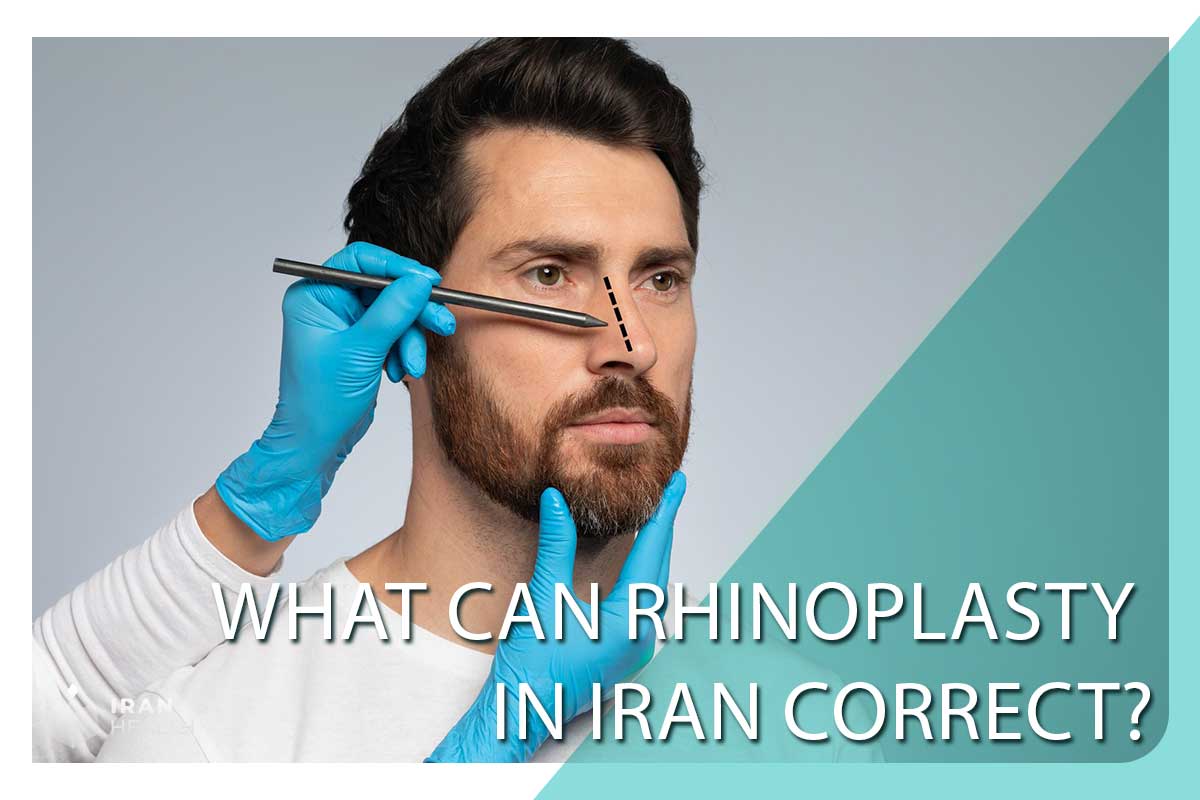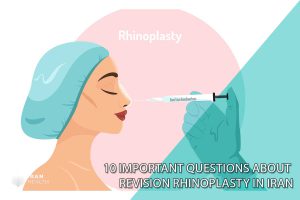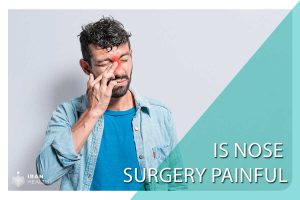The most common problems that rhinoplasty in Iran can correct: Below is a list of the most common concerns expressed about the appearance of the nose, which leads people to discover rhinoplasty in Iran. Be sure to read to the end to know what is important before choosing a plastic surgery in Iran to shape or resize the nose.
1. The nasal bridge is very flat or wide for rhinoplasty in Iran
The type of nose that is wide or flat on the bridge is especially common in many Asian, African and Spanish tribes.
Asian rhinoplasty procedure can correct this problem by reducing the width of the bridge of the nose, adjusting the tip of the nose, and shaving the base of the nose.
The procedure most often used for flat or low bridges is called “Augmentation Rhinoplasty in Iran”, which may involve the use of bridge implants.
After nose bridge augmentation operation, most patients will notice a large improvement in the overall contour of the nose and a change in facial appearance.
But you should be aware that the healing process may take a year or more for the swelling to go away completely. Like many things, it can take time to get used to different look, even if you like the result.
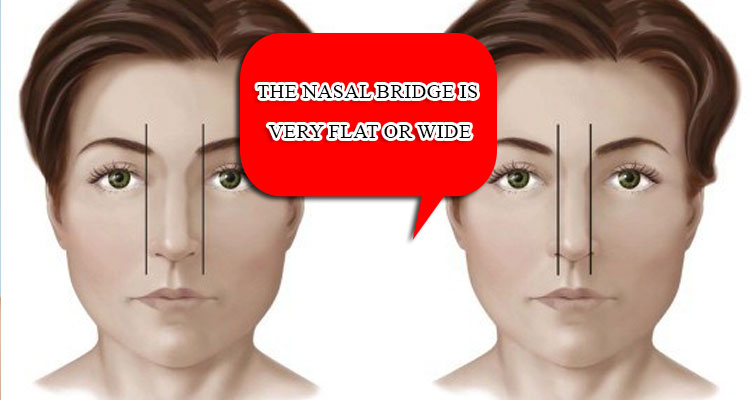
2. The nose has a large tip for rhinoplasty in Iran
Patients who complain of this feature of the nose are inclined to have a rounder tip of the nose due to the shape of the lower lateral cartilage.
If you have a large nose tip, it can make your nose look disproportionately large, too wide, or even both.
Rhinoplasty in Iran can easily correct the large and rounded tip of the nose by reshaping the lower lateral cartilage.
3. The nose is assumed too big or long
When a person’s nose is very large or long – or both – it can become the focus of unwanted attention or bullying.
A large or long nose can also reduce other attractive facial features.
This may require a complex rhinoplasty in Iran, which involves reducing the tip of the nose along with making the nose shorter and smaller, which can involve well-developed nasal reshaping techniques.
However, this rhinoplasty can help the person to have a more balanced face profile and the front view that completes the whole face.
4. The nose is very pointy for the patient
Sharp nose is often the result of protrusion of the cartilage of the nasal septum or extra cartilage at the tip of the nose.
Reduction of this cartilage through nose reshaping operation is usually very effective over the long-term once any swelling fades.
Rhinoplasty procedures to change the pointy nose can not only reduce the size of the nose, but also round the tip of the nose, leading to a softer looking tip appearance.
This in turn changes the overall appearance of the nose and the overall balance of the face.
Downtime is short with tip only nose job in Iran and recovery is potentially not long.

5. The nose is crooked
A crooked nose can be due to injury or trauma to the face during birth period.
A crooked nose can be caused by hereditary factors – including overgrowth of cartilage and bone that eventually leads to pulling part of the nose off to one side.
Asymmetry is another problem (imbalance of the lateral aspects of the nose), especially if it is quite noticeable or severe.
This kind of “cosmetic defect” is often more difficult to fix.
Rhinoplasty can effectively correct the problem. However, this procedure should only be performed by an experienced plastic surgery in Iran.
To correct a very crooked nose, the nasal bones usually need to be reset by osteotomy.
This is a relatively complex and often more invasive procedure compared to tip rhinoplasty or bridge augmentation.
6. The nose has a raised hump or nose-bridge bump
Nasal hump can be very different in size and detract from the rest of the face by distracting attention away from the eyes.
When consulting with your specialist plastic surgery in Iran, it is important to discuss the extent of the reduction you desire in hump.
Some patients may prefer to remove the hump completely to make the nasal bridge completely straighter.
Other patients may choose to keep some bridge fullness in order to retain ethnic or family features.
However, what you do with your body should only be your choice and after receiving complete information to make a well-informed decision.
7.The size of the nostrils
Nostrils that have an unsatisfactory size can also be changed. The doctor will make a small incision at the point where the nostrils meet the cheeks to adjust the tissues if necessary.
8.Nasal Asymmetry
If your nose does not look symmetrical, your doctor can make the necessary changes to bring it into better symmetry and balance with the rest of your face.

9.Birth defects and abnormalities
Some nasal defects are congenital or visible from birth. Rhinoplasty can correct these conditions to improve the appearance and shape of the nose.
10.Injuries
When sports injuries or other traumatic injuries occur, it may be necessary to adjust the structure of the nose to reverse the injury. Reconstructive rhinoplasty can correct nasal injuries so that it looks like the nose was never injured in the first place.
11.Previously bad rhinoplasty
Problems with previous rhinoplasty can be corrected with secondary rhinoplasty. Patients should wait at least a year before secondary rhinoplasty to make sure their nose is completely healed from the initial operation.
Does rhinoplasty help you breathe better?
Nose job in Iran can alter cartilage, bone, skin, and sometimes all of them. While most patients choose rhinoplasty solely for cosmetic reasons, many valid medical concerns necessitate this surgery. Every year, countless men and women suffer from nasal breathing problems that cause frequent nosebleeds, colds, dry mouth, sleeping problems and snoring problems. Common issues that can cause nasal obstruction or difficulty with breathing include:
1.Congenital disorder or cleft palate
2.Enlargement of the turbinates or mucosal structures inside the nose
3.Nasal valve collapse due to injury or trauma
4.Septum deviation
5.Narrow nose bridge or small nostrils
6.Polyps or nasal masses
One of the most common reasons for medical nose surgery in Iran is to correct the deviation of the nasal septum. It is a medical term used to describe when the central cartilage of the nose is off-center and makes it difficult to breathe properly.
Abnormalities in the structure of the nose are often associated with respiratory problems. Functional rhinoplasty in Iran can smooth the partition between the two nasal cavities called the nasal septum and make it easier for patients to breathe on both sides of their nose.
At the same time, patients can choose to have medical and cosmetic concerns addressed, allowing for one surgery and recovery period. rhinoplasty in Iran to correct respiratory problems not only has cosmetic benefits, but can also help improve the patient’s quality of life.
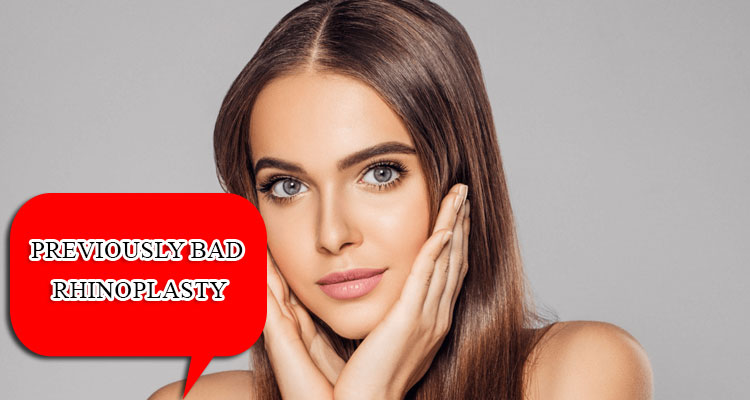
Reversibility of the fleshy nose or hump after rhinoplasty in Iran
People have many questions and concerns about the process of their nose job in Iran. One of the most pressing questions is about the regrowth and return of the nose. The fact is that the body is consistently altering. This alteration may be because of weight loss or even weight gain. Changes also occur with age. Rhinoplasty in Iran is a surgery performed to correct a nasal deformity or simply to change the appearance of the nose. Of course, most patients seek permanent surgical results. However, few are concerned about the return of the nose shape.
Nasal reversibility after rhinoplasty in Iran
Although there is a small risk that the nose will grow back and return to its original shape after rhinoplasty, there are other complications that can occur after rhinoplasty in iran, so prospective patients should be careful in choosing a plastic surgery in Iran and make sure that they are ready for nose job.
1.Age
First, it is important to note that the nose continues to grow after adolescence. The nose grows until the person reaches their late 20s on average. This is something that should be taken seriously, especially if a teenager is involved with this surgery. The fact is that the nose job performed on a teenager may be accompanied by some minor changes or deformities, because teenagers also grow after puberty. However, some teens undergo rhinoplasty in Iran and do not have any changes in their nose as they get older. Some surgeons still refuse to operate on adolescents because of puberty. Other surgeons may perform a nose job if the teen’s nose is damaged or if there is a deformity that requires immediate attention.
2.Unforeseen events
The results of rhinoplasty in Iran should be permanent but there is no guarantee and complications may occur due to structural problems, disease or injury.
The fact is that many cases are out of the hands of plastic surgeons. Accidents happen to the patient, the patient may experience complications after surgery.
People experience unpredictable changes with aging. All of these special conditions cause a change in the shape of the nose that may cause it to grow back.
The tip of the nose is made mainly of soft and cartilaginous tissue that heals and deforms years after surgery and as the patient ages. It is significant to know that unpredictable circumstances may happen. The best course of action is to make sure that the plastic surgeon is very skilled and trained in performing this surgery.
Is nasal hump reversible after rhinoplasty in Iran?
The nasal hump probably returns to a certain extent after rhinoplasty in Iran. In some cases, the patient develops a callus in the postoperative period, which is actually a reaction to the damaged bone, resulting in thickening.
In some cases, it may give the impression that the nasal hump is back. Nasal hump does not return as much as it did before surgery and will not be completely reversible, but sometimes there may be slight irregularity in the bridge due to swelling and callus formation in the nasal bones.

Return of the nose after surgery
If severe changes in the nose occur, the patient should consult their plastic surgeon. The surgeon will most likely recommend reconstructive surgery to restore the nose. It is important to know that this process is very dangerous.
The surgeon will deal with a weakened structure in the nose. In addition, the operation is likely to leave very significant scars. If the nasal hump returns after rhinoplasty in Iran, the surgeon recommends revision rhinoplasty in iran to correct the malformed hump and recommends that you wait 6 to 12 months after the initial surgery for reconstructive surgery.
Often the callus created or the swelling that occurs resolves on its own. In fleshy noses, due to the thickness of the skin, the swelling lasts longer after the operation and the patient thinks that there is no change in the nose or that his nose is reversible.
Before the operation, the surgeon will discuss your treatment and goals. You will then receive some sedatives followed by general anesthesia. Incisions may be limited to the inside of the nose (closed rhinoplasty in Iran) or may incorporate an extra small incision under the tip of the nose (open rhinoplasty).
When incisions are made, the skin of the nose separates from the underlying bone and cartilage. What happens next depends on each person’s specific circumstances. Cartilage may be displaced or lost structures replace.
When the desired result is achieved, the skin is placed on the new structure and the incisions are closed. Reconstructive rhinoplasty usually involves less pain and bruising than primary rhinoplasty in Iran.
Patients should be careful in choosing a plastic surgeon and make sure they are ready for rhinoplasty. Good results are obtained from a skilled surgeon and artist, proper preparation and communication, quality of follow-up care and realistic expectations.
Patients should make sure that all of these conditions are checked before rhinoplasty in Iran to avoid adverse outcomes and poor decision making.
